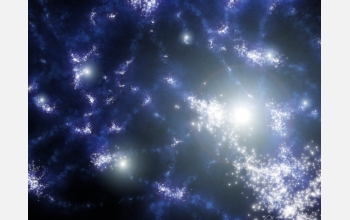|

Press Release 05-193
Scientists See Light That May Be From First Stars in Universe

The long-sought Population III stars would have been up to 100 times more massive than the Sun
November 2, 2005
Scientists using the National Aeronautics and Space Administration's (NASA's) Spitzer space telescope say they have detected infrared radiation that may have come from the earliest objects in the universe.
The light is too distant and feeble for the Spitzer to resolve individual sources; the science team, based at NASA's Goddard Space Flight Center in Greenbelt, Md., compares it to the glow of a distant city seen at night from an airplane.
But after data analysis funded in part by the National Science Foundation (NSF), the scientists believe the radiation is giving them a glimpse of the infant universe more than 13 billion years ago, when the fading embers of the big bang were just coming back to life.
The Goddard team says it's possible the light is coming from hot gas falling into the first black holes to form in the universe. Or, the light could be coming from the very first stars, the long-hypothesized Population III stars. (Population I and II stars, named by order of their discovery, comprise the familiar types of stars we see at night.)
If that is the case, theory suggests these first stars were likely over 100 times more massive than Earth's sun. This would have made them extremely hot, bright, and short-lived, with each one burning for only a few million years. By now, however, fierce ultraviolet light emitted by these Population III stars would have long since been stretched to lower energies by the universe's expansion--or "redshifted"--which is why the Spitzer telescope is currently picking up that light in infrared wavelengths.
The science team, led by Alexander Kashlinsky of Science Systems and Applications, Inc., has published their results in the Nov. 3 issue of the journal Nature.
For more information, see the NASA news release.
-NSF-

Media Contacts
M. Mitchell Waldrop, NSF (703) 292-7752 mwaldrop@nsf.gov
Dewayne Washington, Goddard Space Flight Center (301) 286-0040 Dewayne.A.Washington@nasa.gov
Principal Investigators
Alexander Kashlinsky, Science Systems and Applications, Inc. (301) 286-2176 kashlinsky@stars.gsfc.nasa.gov
Related Websites
Spitzer Space Telescope site: http://www.spitzer.caltech.edu/spitzer/index.shtml
NASA news release: http://www.nasa.gov/vision/universe/watchtheskies/universe_objects.html

The National Science Foundation (NSF) is an independent federal agency that supports fundamental research and education across all fields of science and engineering. In fiscal year (FY) 2009, its budget is $9.5 billion, which includes $3.0 billion provided through the American Recovery and Reinvestment Act. NSF funds reach all 50 states through grants to over 1,900 universities and institutions. Each year, NSF receives about 44,400 competitive requests for funding, and makes over 11,500 new funding awards. NSF also awards over $400 million in professional and service contracts yearly.
 Get News Updates by Email Get News Updates by Email
Useful NSF Web Sites:
NSF Home Page: http://www.nsf.gov
NSF News: http://www.nsf.gov/news/
For the News Media: http://www.nsf.gov/news/newsroom.jsp
Science and Engineering Statistics: http://www.nsf.gov/statistics/
Awards Searches: http://www.nsf.gov/awardsearch/
| 

